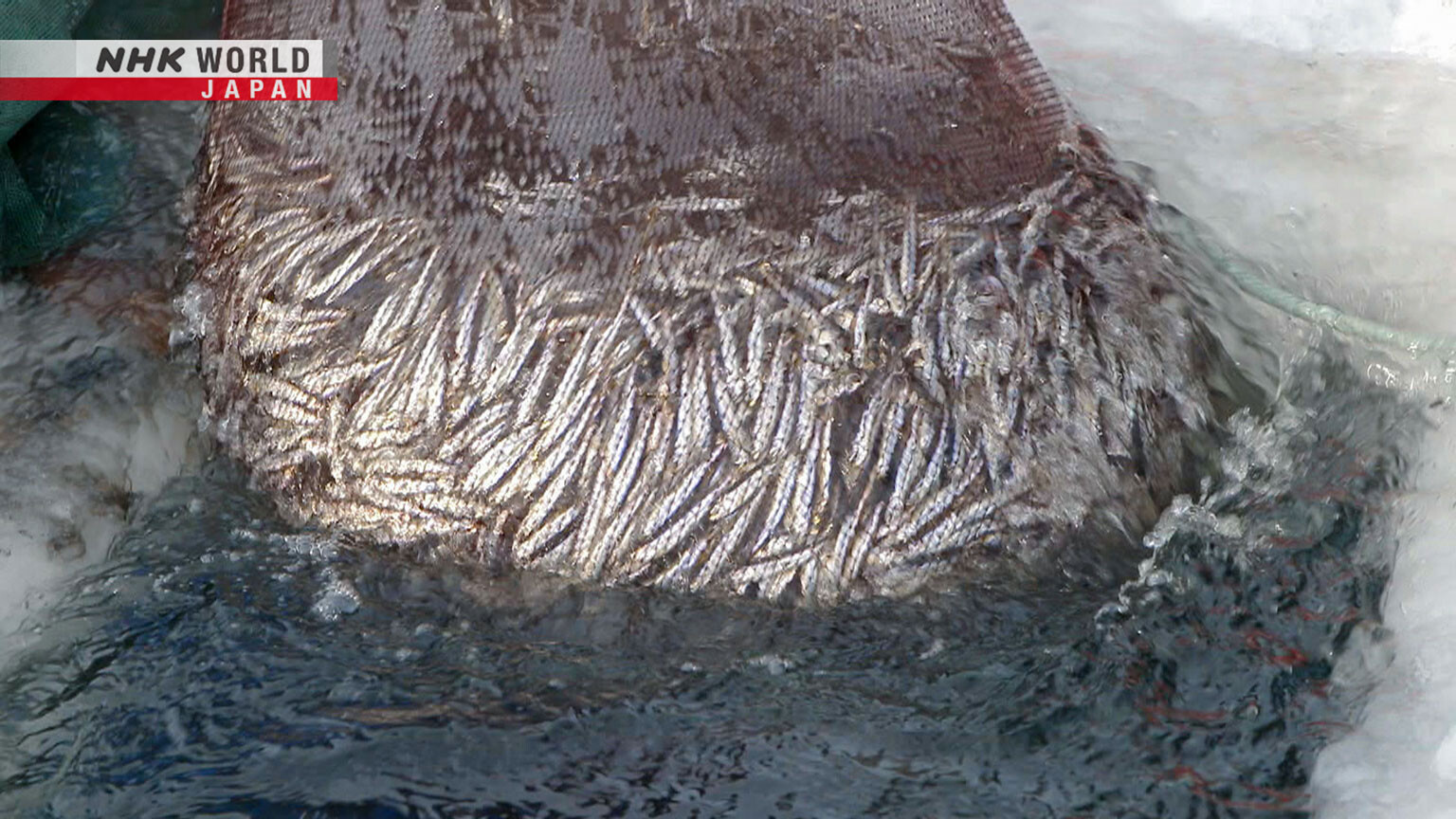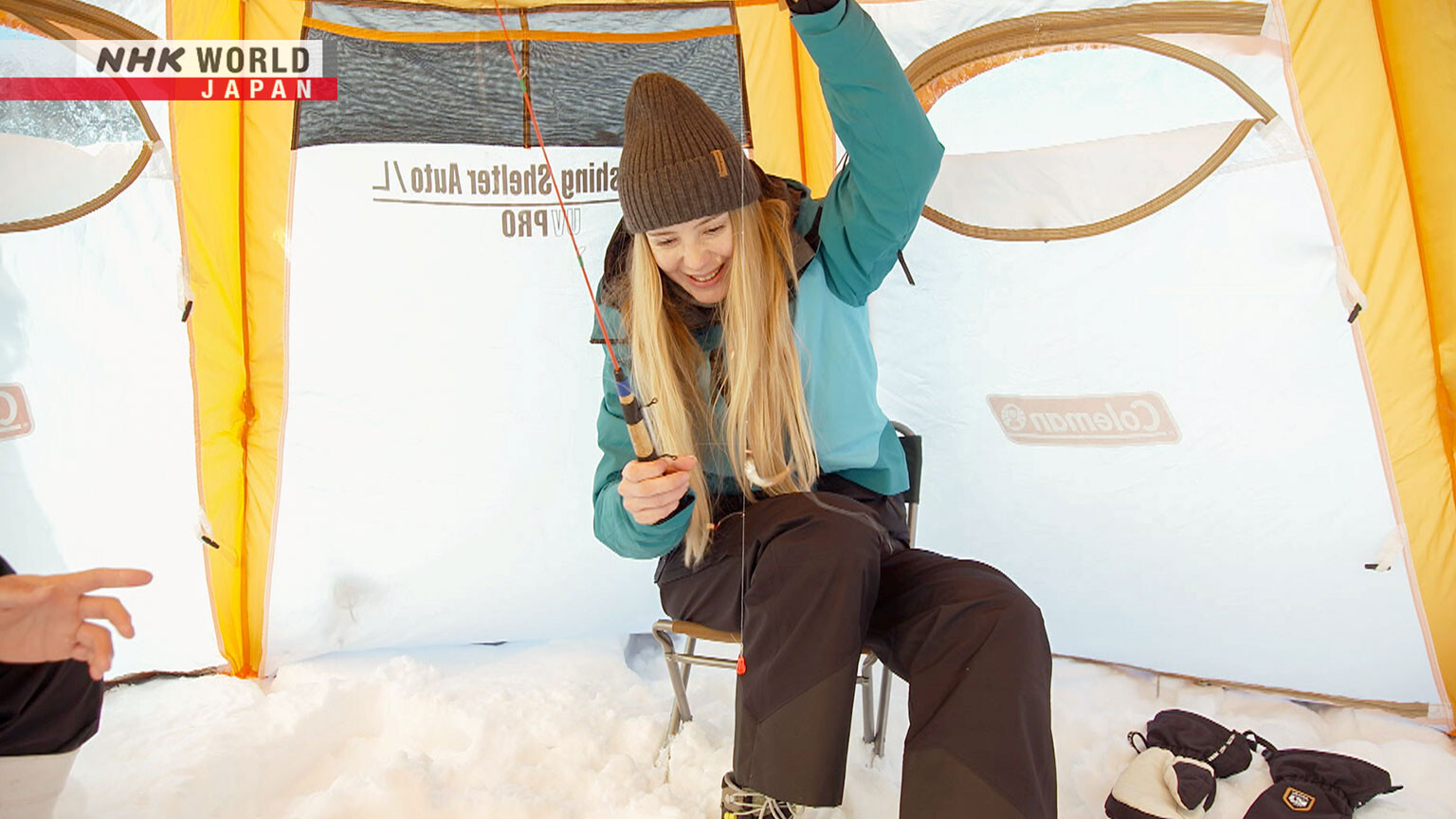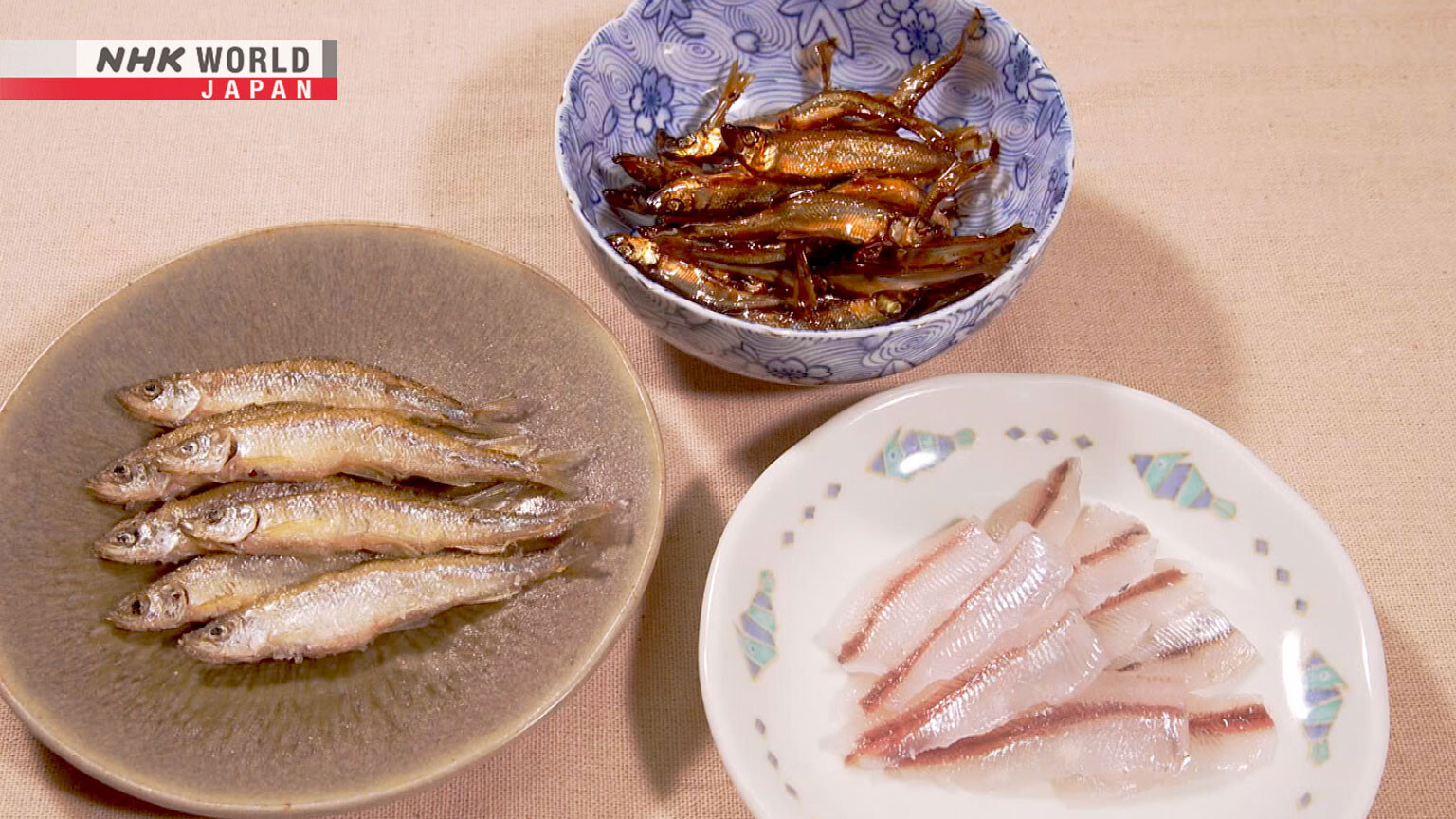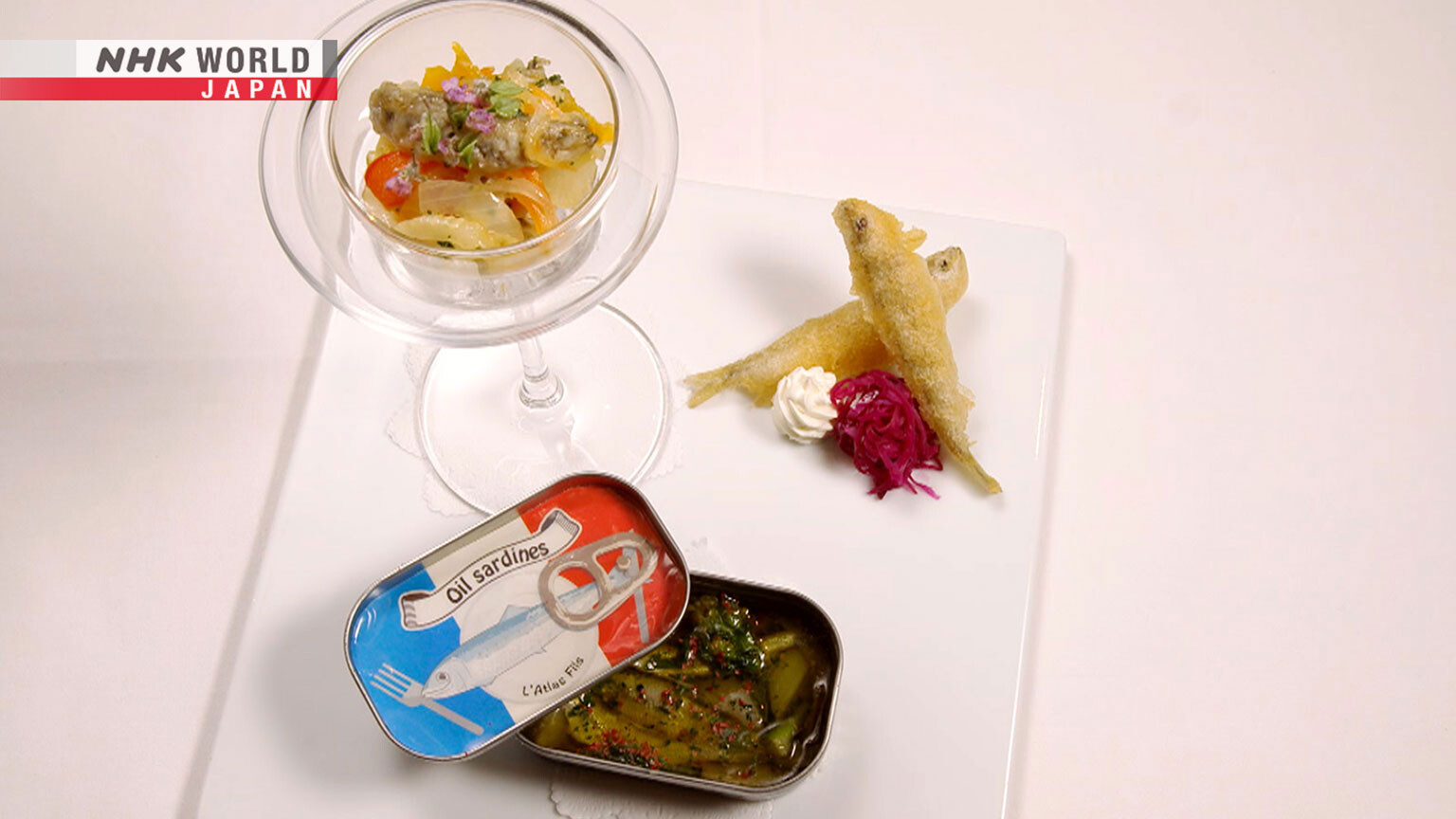WAKASAGI
Wakasagi—small, 10-cm fish—are the star of Japan's winter fishing season. Drill holes in an icy lake for some line fishing, and meet fishers who are passionate about conservation efforts. (Reporter: Janni Olsson)




Transcript
Tokyo: this world-class metropolis is a veritable gourmet wonderland.
Discover the stories behind the ingredients that make this city so delicious - so "oishii."
This time, we focus on wakasagi, or pond smelt.
"Waka" means young, "sagi" means small fish.
As the name suggests, it's only about 10 centimeters long.
It lives in cold waters in the northern Sea of Japan, the Sea of Okhotsk, and around Alaska.
Wakasagi fishing is popular in winter.
Got a bite! Good.
It's an easy-going activity for all ages.
- Got one!
- Nice!
But the best part is eating it freshly caught, on-site.
"Oishii."
With a plump texture and light sweetness,
it's great in both traditional home cooking and innovative modern cuisine.
Let's find out more about wakasagi, a fish that's been loved in Japan for ages.
Get your fishing pole!
Trails to Oishii Tokyo.
Hello, my name is Janni Olsson, and the theme of today's show is wakasagi.
Now, I have been living here for more than 10 years, but I have never eaten this fish before.
So, let's go and find out some more.
Our Swedish reporter Janni arrives at Toyosu Market, home to around 500 seafood wholesalers.
This wholesaler occupies the largest space,
selling over 300 products from catches of the day to various delicacies.
- Hello!
- Good morning.
I'm looking for wakasagi.
Right here.
- So tiny!
- That's right.
In my country, tiny fish aren't so common.
Oh, we eat a lot of mackerel like this.
- These really are much smaller.
- Right.
This mackerel is 50 centimeters long, the wakasagi is 10.
At most, they only get up to around 15 centimeters.
Getting ready to explain their key traits is Yamazaki Takafumi, who's been handling wakasagi for 20 years.
Pretty. Shiny like a mirror.
Fresh, tasty ones have a silver sheen and firm body.
- They sure look tasty.
- Yes.
Wakasagi are found in lakes and rivers across Japan, from Hokkaido all the way down to Kyushu.
They're sold in the markets all year round,
but are in season from winter to early spring, before spawning begins.
The bones are soft.
They're great eaten whole as tempura, deep-fried, grilled with a bit of salt, and more.
Ones with eggs inside are extra tasty.
Janni's there in early March, in the middle of wakasagi season.
- See?
- That's a lot. Wow!
Japan loves fish roe. Eating wakasagi is a great way to welcome spring.
- You look forward to eating it in winter?
- We begin craving it.
Colder regions to the north get the most wakasagi,
with Hokkaido and Tohoku accounting for 80% of Japan's catches.
For 10-cm wakasagi, the wholesale price is about 13 dollars per kilogram, or around 20 dollars for larger ones.
The price has nearly doubled in the past 10 years due to smaller catches and other factors.
These days, it's nicknamed the "tiny luxury."
How are they caught?
Fishers use nets. For leisure fishing, you dig a hole in the ice and drop a line.
Winter line fishing.
You can still do line fishing at Lake Abashiri in Hokkaido.
Go have a look. You may enjoy it.
Yeah?
Excited about her new, tiny discovery, Janni is ready for a trip to Hokkaido.
She's off to Lake Abashiri, a famous wakasagi fishing ground.
Abashiri, located in eastern Hokkaido, is about a 2-hour trip from Tokyo.
It's an hour and 40 minutes by plane and another 20 minutes by car.
The thriving fishing town faces the Sea of Okhotsk.
From late January to early March, tourists can see drift ice along the coast.
Look at this. So pretty.
Luckily for Janni, drift ice and wakasagi season are one in the same.
Off to the lake!
Ah, look! The tents out in the snow!
Tents are set up on the ice.
Fee station.
- Hello.
- Hi.
This is wakasagi bait.
Wow, it's very small.
Pay a recreational fishing fee, get some bait, and you're good to go.
Right here in front of us. This is the edge of the lake.
Wow, it's a big lake.
It looks like a big snowy field, but it's all lake covered with ice and snow!
You can rent everything you need, even tents and fishing lines.
So if you're a novice, don't be shy!
The ice is 60 centimeters deep.
Just use an electric hole driller!
It's warm here. I could stay in here all day.
Drop in the line and shake it lightly from time to time to attract the fish.
Hold it in place, and wait patiently.
Five minutes in.
- Got a bite!
- Lift it up straight!
There it is! Awesome!
Lovely! So cute.
And lively!
Shiny like a rainbow.
This is fun!
If you're lucky, they bite right away. You can catch a lot one after another.
It's nibbling.
Gotcha!
Lake Abashiri is brackish, with saltwater from the Sea of Okhotsk flowing in through the Abashiri River.
Lake-born wakasagi venture out to sea to eat plankton and return to the lake to spawn.
They're raised on gifts from the sea.
It's negative 5 degrees Celsius - gotta keep warm in those tents!
Tastes so good.
Kids enjoy it too!
It's fun for all ages.
Got one!
I got two! No, three!
Got two!
Nice.
Janni catches 22 wakasagi in three hours.
- Thank you.
- You caught a lot.
Back at reception, they rinse the fish and mix them with tempura powder.
Then, you can cook them yourself!
"Itadakimasu."
"Oishii!"
Crispy. Soft inside. And sweet.
I can't stop.
It's great eating what you've just caught.
From January to March, wakasagi fishing at Lake Abashiri attracts up to 900 people a day, or 15,000 each year.
It's a winter tradition that everyone looks forward to.
Pro fishers also go to the lake every season.
7 AM - negative 10 degrees Celsius.
Janni visits Yobito Fishing Port, near the lake.
- Good morning.
- Good morning.
How do you fish for wakasagi on top of all this ice?
- We use nets.
- Nets?
I'll show you.
No boats - snowmobiles!
Janni hitches a ride with Saso Hidenobu.
10 minutes out.
Let's see how they do it.
Ropes are set up under the ice in a fan-like formation, which are used to hold a large net in place.
Under-ice net fishing is banned until the ice gets around 20 cm thick.
First, holes are drilled 20 meters apart.
These long wooden planks will be used to pass rope under the ice using the holes as relay points.
Once the rope frame is installed, a 200-meter-long pouch made of net is fed along it.
We put the net inside and spread it left and right.
The net is attached to each pole and spread out in a fan shape.
Then, it's pulled up from the center part of the pouch, where all the fish should be!
There they are! Lovely!
And just like that, wakasagi are scooped out from under the ice.
So pretty. Silver and shiny.
They can get up to 200 kilograms of fish in one go.
- Very interesting fishing method.
- Quite rare.
It's a first for me.
We use this method all around the lake.
All wakasagi from Lake Abashiri are taken to a nearby port.
Up to 4 tons are landed in one day.
The fish are passed through a metal detector to check for hooks and other objects.
Then, they're sent to distributors.
How long will you continue working?
Depends on the catch volume, but maybe until mid-March.
- Almost done?
- Right.
We have to choose some fish to preserve for conservation efforts.
- So you're entering the final stage.
- Yes.
Using freshly landed wakasagi, Saso's friend will prepare something for Janni that fishers love to eat.
Meet Chiba Hiroshi.
Wow.
He cuts larger wakasagi into three slices...
and carefully peels off the skin.
It's sashimi!
A true fisher's delight made with freshly-caught wakasagi.
It's firm with a gentle flavor.
It's almost a little crunchy.
Now, deep-fried.
Frying in oil makes it sweet and tender.
Hot, hot, hot!
Janni doesn't hold back!
So good!
Last but not least, wakasagi "tsukudani."
They simmer in a broth of sugar, starch syrup, soy sauce, and salt for about 20 minutes.
They've soaked up the sauce, so I think it's ready.
He uses the same sauce over and over, so it's packed with fish umami.
The simmered wakasagi are perfect with rice.
Great combo. I like this the best so far.
It's great that wakasagi can be eaten whole.
Those from Lake Abashiri are particularly good.
I want more people to try them.
Abashiri fishers are also active in conservation work.
Once the ice has melted in spring, they collect eggs,
fertilize them, and release fish into the lake after hatching.
They've been doing this for over a century.
Up to 2 billion eggs are fertilized each year.
Some are stored and the rest are shipped.
Abashiri-born wakasagi are growing up all over the country.
Japan considers wakasagi an important fishery resource.
Efforts to protect the fish go beyond Abashiri.
Next, Janni visits Hakone, a popular hot spring resort town in Kanagawa, south of Tokyo.
They have "tsukudani" here too.
Lake Ashinoko near Mt. Fuji is another key location for wakasagi.
A lakeside fishing cooperative runs a unique egg sourcing and hatching operation established 25 years ago.
In charge of breeding operations is Yuki Yosuke.
These covered tanks are filled with wakasagi taken from the lake the previous day.
They were caught about 22 hours ago.
They're alive?
Wakasagi lay eggs after sundown.
Covering the tanks with lids creates an artificial nighttime, which fosters spawning.
We keep them in here for a day and then take out fertilized eggs.
The fertilized eggs are the ones that have a yellow hue.
Normally, eggs stick to rocks and other things in the water.
If left in tanks alone, the eggs would stick together and suffocate.
Here's what they do.
- We use this powder.
- What is it?
Natural pottery clay.
As the clay powder dissolves in water,
it forms a film over the surface of the eggs, keeping them from sticking together.
These are incubators.
Water rises from the bottom.
We need to keep the eggs from simply floating to the top.
How, you may ask?
With a glass marble.
We drop it in.
Hear it banging around?
It moves water around and provides more oxygen to the eggs.
So many eggs.
Today, this is about 6 million.
The eggs take 10 to 14 days to hatch.
The incubator is connected directly to Lake Ashinoko,
so fish can be easily transported once they've hatched.
They keep a small portion of mature wakasagi to use for processing and return the others to the lake.
Amazing.
Known as the "Lake Ashinoko method,"
the eco-friendly process has been adopted by other cooperatives in recent years.
Excess fertilized eggs are shipped to lakes and other areas in refrigerated containers.
Are these native to Lake Ashinoko?
They were brought from Lake Kasumigaura in the early 20th century.
They were also purchased from Lake Abashiri and other areas in the past.
Originally, wakasagi were only found in brackish lakes and rivers in certain parts of Japan.
They were limited to places like Hokkaido, Ibaraki and Shimane.
To expand resources, wakasagi cultivation was spread to other areas in the early 20th century.
This was possible because the fish can adapt to a wide range of temperatures and salinity.
We relied on other areas for decades.
We've become independent cultivators over the last 20 years.
We hope to continue conservation efforts with other lakes.
A nationwide effort to conserve precious wakasagi, one lake at a time.
This passion and determination had a lasting impression on Janni.
The final stop is Shinjuku, Tokyo.
Chic cafes and restaurants in the area continue to wow foodies from Japan and beyond.
Janni heads to a modern French restaurant next to a museum.
- Welcome.
- Hello.
The restaurant specializes in course meals.
Chef Sagae Ryo has a knack for using seasonal ingredients with a traditional flair.
Today, he prepares a winter course with wakasagi.
Three wakasagi appetizers.
Beautiful.
Starting off the course - a wakasagi sampler with three ways to enjoy the fish.
I want customers to get excited about what's coming next in the course.
Wakasagi fritters, with roe inside.
Soda water is mixed with flour and baking powder for added crunch.
This is ajillo.
Wakasagi and seasonal veggies like white asparagus are cooked in olive oil, garlic and spices.
Last but not least, escabeche.
Fried wakasagi is stewed with onions and other veggies, then soaked in vinegar overnight.
He serves it over ice.
He calls it... wakasagi on ice!
It's inspired by wakasagi line fishing.
It's chilled. It reminds me of line fishing on an icy lake.
It's very refreshing.
Subtle, elegant flavor.
"Oishii."
The next dish is a savory wakasagi sampler inspired by a French gateau.
It consists of terrine made from wakasagi simmered in soy sauce, sake and sweet cooking wine.
On the side, a scoop of savory ice cream made using 50 wakasagi.
Soft and rich.
In Sweden, we like to spread pate over bread. It reminds me of that.
But it doesn't taste the way it looks. It's fun and exciting.
My grandma made wakasagi "tsukudani" for me when I was a kid.
This is in homage to that.
This is an unforgettable dish.
Thank you.
Although it's a tiny fish, I wanted to find ways to make it the main ingredient.
I wanted it to be the star of the course.
It works well with other ingredients, yet it's a strong competitor in the culinary world.
I believe its possibilities are endless.
Wakasagi is a small fish that represents winter for many people here in Japan.
It was my first time to go fishing on a frozen lake,
and let me tell you, it was such an amazing experience.
This little fish is protected by many here and it's loved as well, and they don't take too many.
It's so small that you can eat it all in one bite and it's packed with umami.
I can't wait until I can go fish for it again next year.
In Tokyo, every ingredient has its own story.